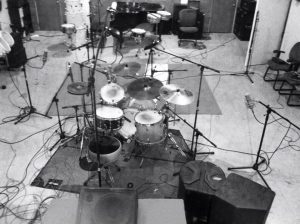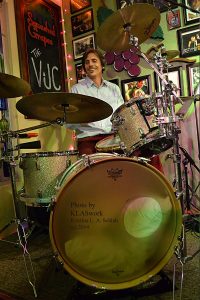What they are saying:
Lessons for Beginning Students:
 With most beginning students being children, preteens and young teens, emphasis is on fun. Students typically finish their first lesson able to play a beat. Beginning student curriculum is typically based on basic rock beats, drum fills and snare work. As people often have different learning styles, I do not use a cookie-cutter approach and instead strive to teach all students in whatever ways work best for them…even if they are adults! (I once had a new student in his 40’s who hated numbers and could not count while he was playing or learning beats. We scrapped the counting and found a very “feel”-based technique for his keeping track of where he was in time. It worked. In six months he was playing professional gigs on a regular basis!)
With most beginning students being children, preteens and young teens, emphasis is on fun. Students typically finish their first lesson able to play a beat. Beginning student curriculum is typically based on basic rock beats, drum fills and snare work. As people often have different learning styles, I do not use a cookie-cutter approach and instead strive to teach all students in whatever ways work best for them…even if they are adults! (I once had a new student in his 40’s who hated numbers and could not count while he was playing or learning beats. We scrapped the counting and found a very “feel”-based technique for his keeping track of where he was in time. It worked. In six months he was playing professional gigs on a regular basis!)
Lessons for Intermediate Students:
Emphasis is on incorporating mechanics of three and four-way coordination, drum fills, snare work, and genres of student’s interest with an increased focus on fundamental components of sounding good such as technique/control/dynamics, metronome studies to solidify tempo and spacing, and foot development. The short-term gratification of beginning studies is giving way to the mid-term gratification of results that come from regular practice.
Lessons for Advanced / Professional Students:
Manifest Your Musical Visions!
Curriculum for advanced and professional students is based on developing the mechanics of the student’s vision as a drummer as well as the diligent development of the finely detailed aspects that are requisite to SOUNDING good.
More details are covered below, but first a helpful insight or two on the path to reaching your drumming potential:
Ever have one of those days when you hear your playing, either live or more likely from a recording, and you think “I really suck!”? You then get real depressed, start moping and even contemplate quitting? You’ve just had an “I really suck” day (an IRSD). If you have, congratulations! Seriously…You have one of the things it takes to become a great player…an improving ear capable of becoming more and more discerning all of the time.
If you soon thereafter stopped moping and then started practicing whatever you needed in order to address your playing’s shortcomings, then you have other qualities, such as resiliency and stick-to-it-iveness, requisite to becoming a great player.
You can never be better than your ear. IRSD’s are days in which your ear has taken a quantum leap. It has become more refined and will enable you to take your playing to a new, higher level. Through practice your skills will eventually catch back up to your ear. States of premature bliss and thoughts such as “I have finally arrived!” are common at this stage. But soon, hopefully, this mania is comes back to Earth as the ear takes another quantum leap and another IRSD forges its way into your musical psyche.
For the committed, this cycle goes on and on. IRSD’s are a real drag until you see them for what they really are: the gateways opening to your becoming a better player. Celebrate them – as painful as they may seem – then go about the business of refining your practice routine to bring about the improvements your ear is guiding you to make.
And be thankful you have IRSD’s and the wherewithal to exploit their potential positives…the eternally average players never or rarely have IRSD’s.
I specialize in working with students who have at least some musical vision for their drumming. Some of the areas I pull from in order to build a practice routine that will help you realize your musical vision as comprehensively and expediently as possible are:
-
Improvisation: Expand your rhythmic vocabulary, effortlessly play what you are hearing;
-
Recording: Get your playing to the canvas as you want it to sound;
-
Ear Training: Again, you can never be better than your ear;
-
Time/Spacing: Solidify your internal clock – fundamental to sounding great in the studio or live;
-
Groove/Feel: Approaching a song as if it were a painting…creating drum parts that not only work well with the rhythm section as a unit but create a great background for the lead and counter melodies, and that are played in that place in the pocket (smack in the middle or slightly behind or ahead) that gives a song that perfect feel;
-
Transitions: Flow through transitions effortlessly and with complete control;
-
Snare Work: Fundamental to control, touch, dynamics, independence, counterpoint and improvisation;
-
Soloing over ostinato (repeating) patterns: Keep the groove going while soloing, be free within control, find a solid and palatable backdrop to any craziness you might be inspired to play;
-
Kick Drum: Develop control and multi-strokes (Why settle for only singles and doubles?)
-
Hi Hat: You have one – Use it! Play it colorfully without tying up the hands;
-
Odd Times: Step into another universe;
-
Odd Phrasing: Add great variety to your book, avail yourself to innovative grooves and fills and never get stuck in an improvisational corner again;
-
Polyrhythms: Add a whole new palette of colors.
References provided upon request.
RATES
30 minutes: $45 outcall if in Ventura
45 minutes: $55 outcall if in Ventura
60 minutes: $65 outcall if in Ventura
I rarely teach 1/2 hour lessons and only do with children who are less than 8 years old. The bulk of a 45 minute or longer lesson is “what” to practice. The remainder of the lesson is “how” to practice. During this time students practice the “what” of the lesson as they typically would on their own time and are taught such concepts as isolating problem spots and making exercises to address these problem spots. The result is a student who excels quickly as he or she has learned to practice most efficiently and productively.
Other Services Available:
Rhythm/groove lessons for other instrumentalists – individual or group. (Same rates as above.)
Band Coaching: Tighten things up rhythmically, arrangement-wise and pitch-wise. (Same rates as above.)
Please message me via facebook https://www.facebook.com/CockyPop/, email me at dougthedrummer1@yahoo.com, or leave a voicemail at 805 844-4502. You can text me at that number also, but sometimes I don’t receive texts in a timely manner or even at all.
For examples of my studio work go to:
http://www.dougthedrummer.com/drumtracks/
For some live videos go to:
https://www.youtube.com/channel/UCq8w0KgjuvW2o7UVMOlTBOg
Here are some sample tracks I’ve recorded that embody many of the concepts I teach:
Snare Work
Improvisation, Rudiments, Control/Touch, Odd Phrasing, Dynamics, Counterpoint
Jazz Improvisation
Up-Tempo Swing and Samba, 1/2 Time Swing Improvisation, Transitions, Soloing Over Bass Drum and Hi Hat Ostinato, Left Hand Counterpoint, Odd Phrasing, Polyrhythms
Seven Times the Fun
Playing to a Click Track, Odd Times, Hi Hat Ostinato, Kick Drum Multi-Strokes, Left Hand Counterpoint, Four Against Seven, Melodic Triplets
Snare and Toms
Improvisation, Rudiments, Control/Touch, Odd Phrasing, Dynamics, Counterpoint,Hi Hat Ostinato
More Snare and Toms
Control/Touch, R-L-L Triplets
More Kick Drum and Hi Hat Please
Kick Drum Multi-Stroke Grooves, Hi Hat Ostinato
Left-Overs
Left Hand Counterpoint, Hi Hat Independence, Right Hand Independence